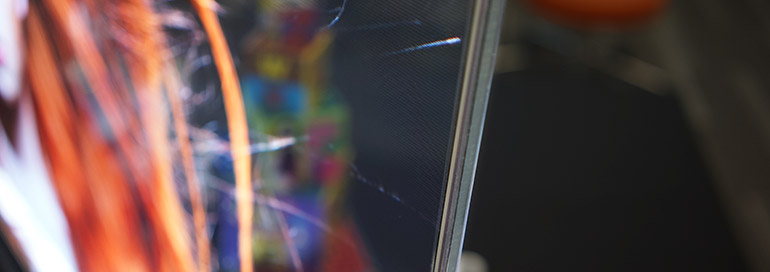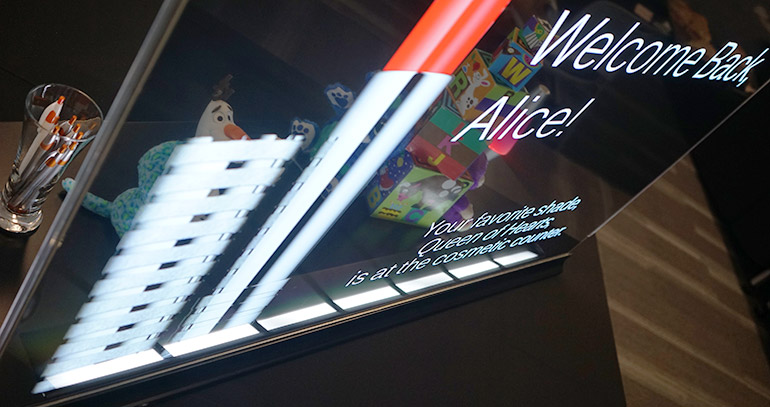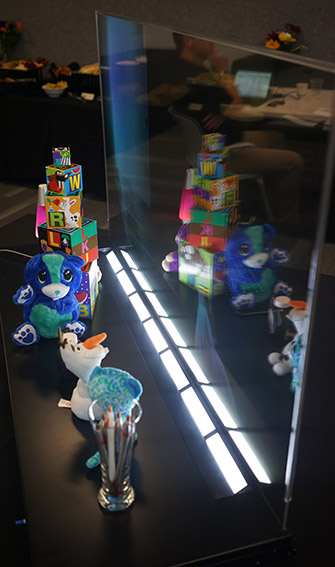We’ve used transparent LCDs in the past, and they’re pretty cool. Evocative of the “see through” user interfaces of science fiction films, transparent LCDs work on the principle of being transparent where their pixels are white, and being opaque where their pixels are black. They also require a ton of light behind them to be seen, and in practical installations, that means building a real lightbox behind them. This makes them great for layering data and content over an artifact case, but it’s not the right solution for every application.
Our friends at Planar have come out with a very impressive transparent OLED (organic light emitting diode) display, and invited us down to spend some quality time with the unit. It’s similar in concept to transparent LCD screens, but the technology and details are very different. Here, where the pixels are black, the screen can be seen through, and whites are opaque. This is far better for reproducing photographic and cinematic content. And oh, what colors can be shown.

A caveat for all comments here – we got to view one of only two prototype units in existence, so one can assume that production units may (rather, likely will) vary from what’s shown here.
The first thing that caught our eye was how the display was incredibly thin: the display itself is, literally, a sheet of glass. Technically, it’s thinner than that — an incredibly thin layer of OLED pixels affixed to a sheet of glass. A thick, heavy base is where the smarts and hardware reside, and the base has a dimmable backlight for any artifacts one would like place behind the display. Light transmission through the screen was better than with a transparent LCD, so less light was needed to illuminate objects behind it. Transparent LCD products we’ve seen are much less transmissive and require significantly higher levels of backlight to make occluded objects visible. However, even with this much improved technology the glass still darkens objects behind, akin to a pair of light sunglasses. You’ll definitely want that dimmable backlight at a minimum.
Our jaded eyes were taken aback by the unbelievable brightness and color saturation of the unit, head and shoulders above any transparent LCD that we’ve seen to date. We’d expect this from a standard OLED display, but seeing such “punch” coming from a 1080p transparent OLED was impressive. Once you go behind the display, you realize that the OLED display is very one-sided; the brightness is extremely attenuated on the opposite side, so this is intended to be a one-sided display (party in the front, business in the back).
What’s missing? We’d love it to be touch sensitive, which it is not, but Planar assures us that it wouldn’t be impossible to custom engineer a touch film or overlay into the unit. Planar said they’re already looking at ways to create 2×1 and 2×2 tiled display walls using this technology. At the time of this writing, it’s technically an all-in-one PC, with a small computer inside of it…naturally, we’d like to have a video input so we can power this unit from a high-performance PC so we can do our usual mix of real-time 3D content on its gorgeous display. For signage, video content, or low-intensity real time graphics, its configuration is most likely sufficient.
At this time, only two units exist. But over time, of course, that will change, and we’re thrilled to have a partner like Planar that can give us such a deep, early glimpse into what the (very, very near) future holds.
In short, we think Planar’s got a real winner, and that this is a fascinating indicator of where the display market is heading. Our clients are always asking for new and differentiated ways to tell their stories. When devices as compelling as the Planar transparent OLED are coming onto the market, we can’t help but feel like the promise of content “floating” on glass just got one step closer to perfection.









